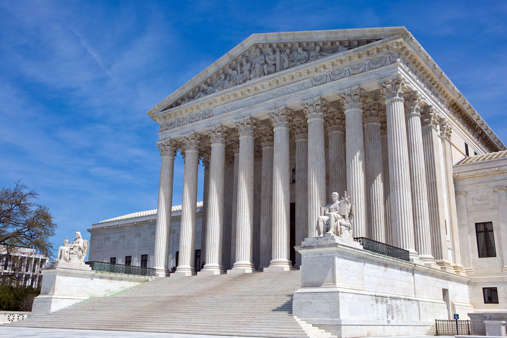Among the monumental and headline-grabbing decisions handed down in the frenzied final days of the 2012-2013 Supreme Court term, one opinion has the potential to dramatically alter the relationship between local governments and property owners. In Koontz v. St. John’s River Water Management District, the Supreme Court waded back into the doctrinal marsh that is Takings Clause jurisprudence and issued an opinion that local governments, permitting agencies and property owners of all sizes and levels of sophistication will be grappling with for years to come.
Koontz has the potential to expand the scope of and uncertainty associated with natural resources development permit-related litigation by exposing “in lieu” of fees and other monetary exactions to challenge under existing Supreme Court precedent that applied to other property conditions imposed on permits. Additionally, because the Court found actionable a permitting authority’s statement made in the course of ongoing negotiations, Koontz may significantly affect how permit conditions are developed and negotiated. Before exploring such repercussions, which may ultimately come to affect permitting relationships of all sorts, though, it is critical to found an understanding of Koontz in the particular permitting dispute before the Court.
Coy Koontz Sr. owned a 14.9 acre property situated within a designated wetlands area in central Florida. In 1994, Koontz applied for a set of permits necessary under state law to authorize the construction of a 3.7 acre commercial development on the northern section of his property including wetlands. In his applications and as required by state law, Koontz offered to offset the environmental damage associated with his proposed development by deeding a conservation easement to the state which would prohibit any future development of the remaining 11-acre portion of his property. The District rejected Koontz’s conservation easement as insufficient to mitigate the damage that would be caused by his development and instead offered Koontz two options: reduce the size of his development to 1 acre and implement a conservation easement over the remaining 13.9 acres, or retain his 3.7 acre development plan and finance an off-site wetlands enhancement project on District-owned land. Additionally, the District indicated that it was willing to negotiate further and review any further alternatives Koontz identified.
With his permit applications still pending, Koontz sued the District in state court, under a state cause of action that provided for the recovery of damages if a state agency’s action is an “unreasonable exercise” of its takings authority. Ultimately, the Florida Supreme Court ordered the dismissal of Koontz’s claim because it held that the United States Supreme Court Takings Clause decisions in Nollan v. California Coastal Commission, 483 U.S. 825 (1987) and Dolan v. City of Tigard, 512 U.S. 374 (1994) – which, together, require permitting authorities to demonstrate a “nexus” and “rough proportionality” between any offsets or exactions imposed and the particular land use for which a permit is sought – did not apply in situations where no permit has actually been issued or where a permitting authority seeks to exact a payment in lieu of mitigation or offset actions related to a specific parcel of real property.
On June 25, 2013, the United States Supreme Court rejected each plank of the Florida Supreme Court’s reasoning. First, all nine Justices agreed that the “principles that undergird [the] decisions in Nollan and Dolan do not change depending on whether the government approves a permit on the condition that the applicant turn over property or denies a permit because the applicant refuses to do so.” Slip Op. at 8.
On the second issue – whether the “nexus” and “rough proportionality” tests applies to monetary exactions – the Court was split 5-4, along now familiar lines. The majority opinion, authored by Justice Alito, held that when a permitting authority requires a permit applicant to make a monetary payment to offset environmental impacts, such monetary demand is subject to Nollan and Dolan. In so holding, Justice Alito first found that the monetary exactions like that at issue, also known as “‘in lieu of’ fees[,] are utterly commonplace . . . and they are functionally equivalent to other types of land use exactions.” Slip Op. at 12. Additionally, Justice Alito concluded that the monetary payment demanded by the District here “operate[d] upon an identified property interest,” and therefore could not be analogized to the simple “retroactive imposition of financial liability” held to be beyond the ambit of the Takings Clause in Supreme Court precedent. Slip Op. at 12. Because the majority found a “direct link between the government’s demand and a specific parcel of real property,” the principles underlying Nollan and Dolan were implicated. Slip Op. at 12-13. Upon finding Nollan and Dolan applicable, the majority remanded Koontz to the Florida state courts to actually apply the “nexus” and “rough proportionality” tests and to determine what – if any – remedy Koontz is entitled to under his state law cause of action.
Though Justice Alito couches the majority opinion as a mere affirmation and application of Nollan and Dolan, it is clear that Koontz is likely to significantly change the relationship between local governments and regulated entities. A few of these implications merit brief introduction now.
The dissent, authored by Justice Kagan and echoed by several early commentators on the Koontz decision, asserts that expanding the scope of the “nexus” and “rough proportionality” tests to cover “in lieu” fees will subject a wide swath of taxes and government fees to challenges based on the Takings Clause. In response, Justice Alito argues that “teasing out the difference between taxes and takings is more difficult in theory than in practice.”
Koontz now provides a new front in land use litigation by arming regulated entities with a potential cause of action. In 1996, the California Supreme Court established that monetary exactions are subject to the “nexus” and “rough proportionality” tests, but limited its application to ad hoc fees and exempted from that analysis generally applicable, legislatively-enacted fees. The California legislature responded by subjecting legislatively-enacted mitigation fees to these tests, so the experiences of local governments and the regulated community in California may prove to be instructive.
Another significant source of uncertainty from the Court’s finding that a position taken by a local agency in the course of negotiations raised a viable Nollan and Dolan question even though that position or demand was never formally incorporated into a permit. The surest means for a local government to avoid opening itself up to attack under Koontz is to simply deny a permit outright rather than engaging in any negotiation of what might be acceptable mitigation, offsets or “in lieu of” fees. Koontz specifically refused to provide any guidance on how to determine whether statements made by regulators in the course of permit negotiations represent “demand[s] of sufficient concreteness to trigger the special protections of Nollan and Dolan.” Slip Op. at 10. Thus, the “concreteness” of a regulator’s putative demand may create uncertainty for permitters and permittees alike and may complicate permit negotiations in a variety of contexts.
These questions left open by Koontz – related to characterizing whether a specific monetary demand constitutes an exaction and identifying the point at which a negotiating statement becomes a demand – should cause permitting authorities to reevaluate their programs and practices and provide significant new tools to developers or other property owners who may wish to challenge decisions or positions taken by such authorities. The fallout from Koontz will be theorized, litigated and studied for years, but for regulators and regulated alike, the process of understanding, addressing, and employing Koontz has already begun.
For more information, contact the Barnes & Thornburg attorney with whom you work, or Fred Andes at fredric.andes@btlaw.com
Visit us online at http://www.btlaw.com/environmental.
© 2013 Barnes & Thornburg LLP. All Rights Reserved. This page, and all information on it, is proprietary and the property of Barnes & Thornburg LLP. It may not be reproduced, in any form, without the express written consent of Barnes & Thornburg LLP.
This Barnes & Thornburg LLP publication should not be construed as legal advice or legal opinion on any specific facts or circumstances. The contents are intended for general informational purposes only, and you are urged to consult your own lawyer on any specific legal questions you may have concerning your situation.









/Passle/6488d4630e7e25c9ac9f834a/MediaLibrary/Images/2024-07-18-19-15-33-047-669969d52008239f764a11af.png)


/Passle/6488d4630e7e25c9ac9f834a/SearchServiceImages/2024-07-17-15-17-44-967-6697e0980752df56d2441ada.jpg)
